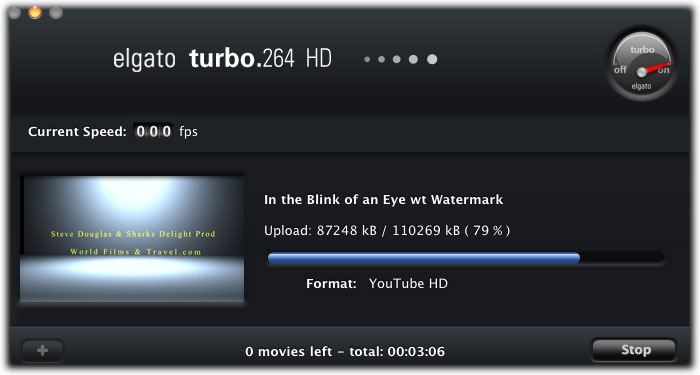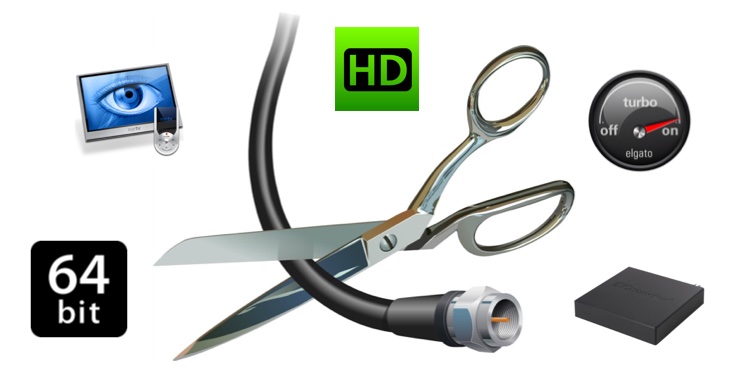Elgato Turbo H264 Software

Power and EleganceEvery once and a while a product comes along that doesn’t just perform well, but, due to its expert engineering and refined user experience, is an actual joy to use. With the Turbo.264, Elgato has seemingly done the improbable: created a sexy hardware video encoder.The widely-used H.264 MPEG-4 codec (used commonly in video podcasts, iPods, iPhones and AppleTV) is a very efficient way to compress video. By and large, you get very good image quality at very small file sizes. There is, however, a price to pay for this combination, and that price is the computing power necessary to play back and encode this very computationally-intensive codec. Generally, long render times are the norm when compressing your video to this format.It certainly seems that, despite all the continuing speed increases in computers, average rendering times are still the same or getting longer. Every time they come up with a faster class of computers, there’s a new, more demanding codec that takes just as long to render.Elgato’s Turbo.264 addresses this problem. The device is a powerful hardware encoding accelerator designed to do one thing: crunch the numbers that make up the H.264 encoding process.
Launch Turbo and drag and drop the video file you'd like to convert into the window. How to remove spam in wordpress contact forms. Select the + button in the bottom left to select multiple files at once.
It takes the heavy lifting off your CPU, freeing it up to do other things, while encoding the data faster than your processor ever could. It all fits into a package just a bit bigger than a standard USB thumb drive. WorkflowIncredibly easy to install, the Turbo.264 device simply plugs into a USB 2.0 port on your Mac. The bus-powered device simply sits there, black and sleek-looking, until it’s needed. While impressively small as a hardware accelerator, the Turbo.264 device is a bit larger than a thumb drive and can be difficult to find room for (on a MacBook, for instance). Thoughtfully, Elgato has included a short USB extender cable that allows you to use the device in the tightest of quarters.You then install the Turbo.264 software. The interface of the application is streamlined and easy to use, elegant-looking in both form and functionality.
A place to drop the videos you want to convert, a drop-down menu to select the device you want to compress to and a start button. The frames-per-second and time information appear in nifty old-school countdown dials. The device comes with several presets for common H.264 devices, including iPods, AppleTV, iPhones and Sony’s PSP. However, you’re not stuck with the presets. You can edit these and even roll your own custom H.264 settings, if you have the need or technical inclination.In addition to the Turbo.264 software, Elgato installs a QuickTime component, allowing you to use its presets in any QuickTime-compatible application. So, for example, if you were editing a sequence in Final Cut Pro, Avid or Premiere, you could export your current timeline directly to the hardware-accelerated rendering of the Turbo.264, without having to leave your editing application.The only real flaw in the Turbo.264 is that it’s a Mac-only product.
Certainly, PC users could not only benefit from the device’s functionality, but add a little style to their systems as well. PerformanceAll the slick design and elegant interfaces are meaningless if the hardware doesn’t perform. So just how fast is the Turbo.264? We’ve put some benchmarks together for both HDV and DV footage for you to see. (Figure 1)As you can see, there are very significant gains to be made in render times with the Turbo.264. Even the fastest Macs can benefit greatly from the hardware acceleration that the Turbo.264 provides.
What’s even better is that, in our blind iPod quality test, our viewers preferred the Turbo.264 footage over the footage from Apple’s Compressor. ConclusionElgato’s Turbo.264 does one thing, and it does it very well. It’s a simple and elegant solution to encoding H.264 material that should more than pay for itself in eliminating wasted rendering time. It’s not only practical in use, but it gives you the satisfaction that only an extremely well-engineered piece of equipment can give.
TECH SPECSSystem Requirements: Macintosh computer with PowerPC G4, PowerPC G5 or Intel Core processor; 512MB of RAM; Built-in USB 2.0 port; Mac OS X 10.4 (or later); QuickTime 7.1.5 (or later); iTunes 7.1.1 (or later)Input Format: Any movie that QuickTime plays and MPEG Program Stream/System StreamDimensions: 1.18″ x 3.34″ x 0.47″Weight: 1.23 oz. Strengths.

Powerful. Elegant.
InexpensiveWeaknesses. Mac onlySUMMARYElgato’s Turbo.264 reduces render times significantly.